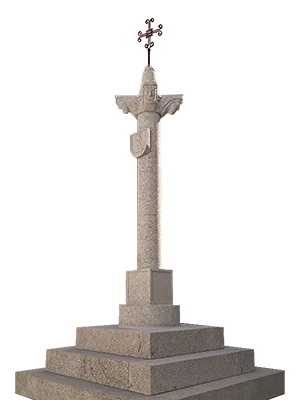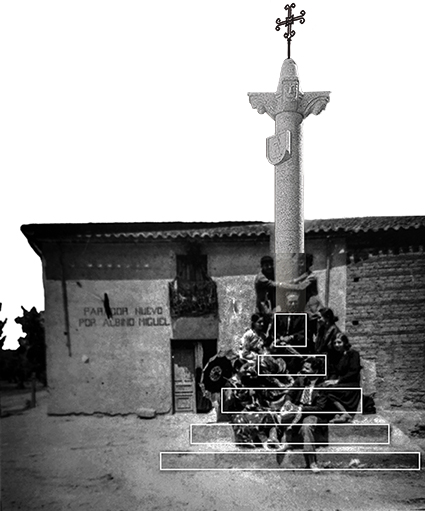7en
PERALEDA CROSS (JURISDICTIONAL ROLLO)
17th century A Rollo in Spain is a large stone column that symbolises the population’s power to impart justice, a symbol going back to the Middle Ages. Peraleda's Rollo dates from the 17th century, though the present one is a reconstruction from the original made possible thanks to some parts of it which were found, the memories of some of our oldest fellow villagers, and the attached photo, which allowed for data confirmation.
A Rollo in Spain is a large stone column that symbolises the population’s power to impart justice, a symbol going back to the Middle Ages. Peraleda's Rollo dates from the 17th century, though the present one is a reconstruction from the original made possible thanks to some parts of it which were found, the memories of some of our oldest fellow villagers, and the attached photo, which allowed for data confirmation.
It was originally placed in a little square which is still known as “El Rollo”, but during the second republic, in the 1930’s, the town council moved it to the present site when they decided to repair it. Apparently, its stones were starting to come loose because children liked climbing to the top, and a serious accident was feared. Finally, during the Civil War, outsider troops demolished the monument and its stones were left scattered in the area for some years before people started taking them away. In 2016 some voices are heard asking its reconstruction, and in 2018 the Town Council consents.
When the king granted a town jurisdictional independence, he also gave it the privilege of erecting a rollo as a sign of that independence and to show that the town now has the capacity of delivering justice. It is true that in many places the rollo was also used as a pillory or gallows for hanging criminals, but not in Peraleda. We had gallows and rollo, and they were both placed in the most prominent places for travellers to see. Being the main road in the past the one going from Belvis to Calzada and being Belvis our reference town, we can say that the rollo was placed at the entrance of the city and the gallows at the exit.
The entrance was a hill where the rollo was readily visible to everyone coming to town, and that place is still called The Rollo. At the exit, outside of town, there is a place where now stands a relatively modern stone cross known today as “The Cross of the Gallows”, maybe erected there as a memorial to all the people who had died there. In this way, travellers arriving in Peraleda found, before entering town, the notice that they were entering a place with its own justice, which could be a warning or a comfort depending on their intentions. Today, the reference town is Navalmoral, so the rollo is now, as it last was, at the entrance of the village as you approach from that place.
Until 1663 Peraleda belonged to the city council of Plasencia, 70 kms away. Just like all the other villages in the same situation, we had to pay much higher taxes than the people living in the city, in addition to being ruled by people who had little knowledge or interest in our fate. No wonder then that our ancestors worked so hard to gain independence.
But for Peraleda the rollo represents more than all that. It is a memorial to an almost epic adventure. We did not achieve independence on our own, but together with other five little villages forming the Consejo de la Campana de la Mata (Council of the Community of the Bush). This political and religious entity consisted of 6 different councils which formed one communal council which in turn was part of Plasencia’s city council. Some crazy entity all right, but that’s not all; the headquarters of such an entity was in the open, on a terrace right by the parish church servicing all 6 villages, St Mary’s, known today as the ruins of St Gregory, 4kms north of Peraleda. It was there, on August 10th 1635, that the Council of La Mata voted for full powers to be given to the parish priest so he could go to Madrid and negotiate the independence from Plasencia.
He finally succeeded and the price was brutal but average. Every family had to pay 10.000 maravedis, and Peraleda, being the biggest and the richest, had to contribute with almost half that quantity. We suppose most families had to go deep in debt, in the hope that future benefits would compensate for the sacrifice. So all the money was collected and sent to the king. Everybody was anxious to start a new life but soon after, grief! bad news arrived from Madrid. Nobody knows anything about that payment. For all they care, the payment never took place.
Meanwhile a nearby town, Casatejada, was also paying to get freedom from Plasencia. Some bad harvests threw them into a crisis and they failed to keep up with their payments, so their council was sent to prison and people were forced to sell the village to a new lord so as to pay for the debts. Peraleda was probably fearing the same fate while the priest, mayors, notaries, dignitaries and anyone with some influence were fighting in Madrid to prove that the payment had indeed being made. Lots of people in debt maybe to no avail, or worse than that, to end up under a much bigger oppressor. We can hardly imagine how people had to live through 28 years of anguish and uncertainty. But to cut a long story short, in 1663 everything was finally sorted out and we got our independence. We then rose our jurisdictional rollo to show the whole world that we were, at long last, free and masters of our destiny. We were unswerable only to the King. Difficult to understand the immense relief those people felt on that day. Today, in memory of our ancestors, that worked so much to erect it, we have erected the rollo here again.

Apóyanos con tu firma para salvar el Dolmen de Guadalperal y también para salvar el retablo esgrafiado de Peraleda.


